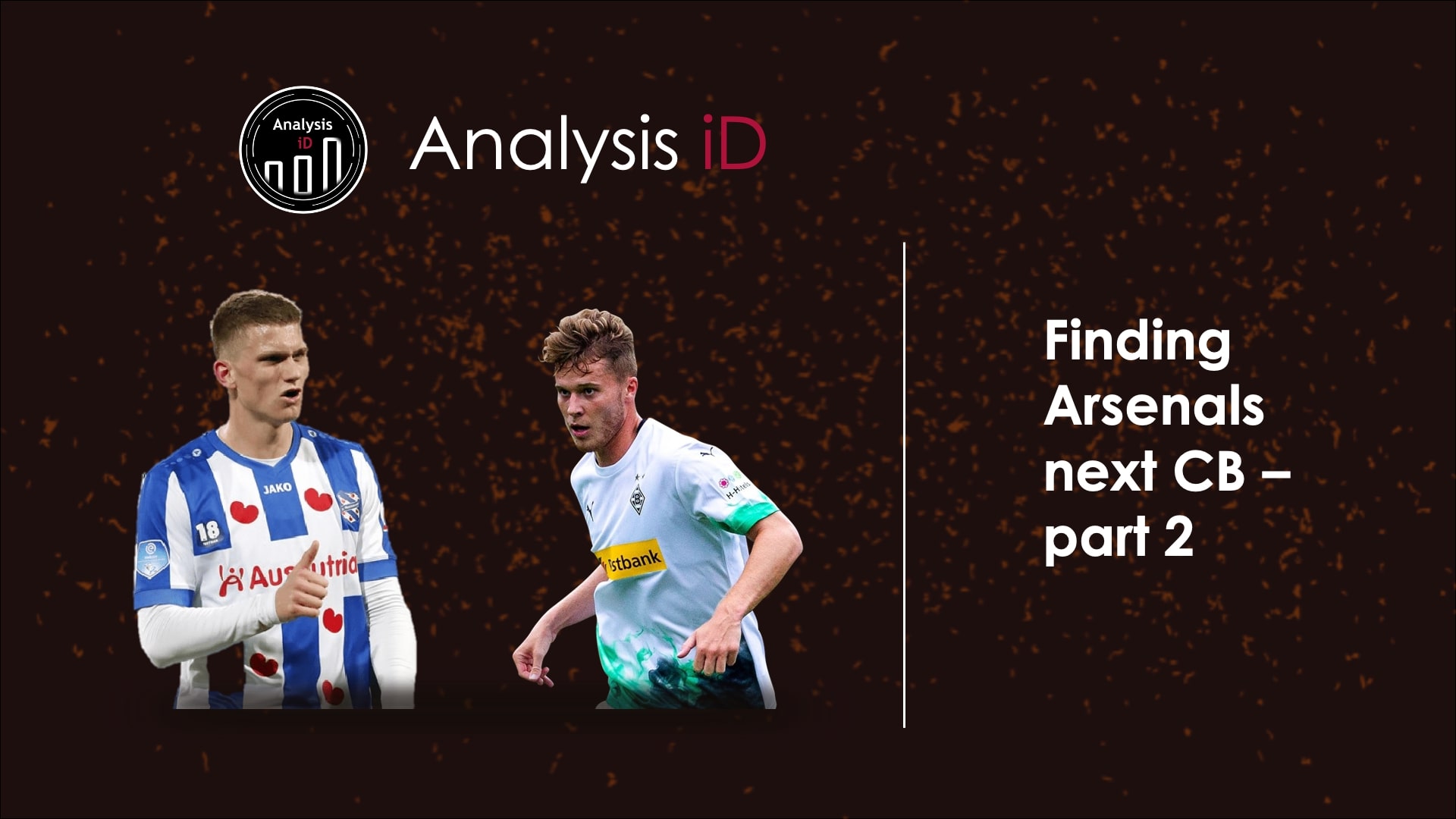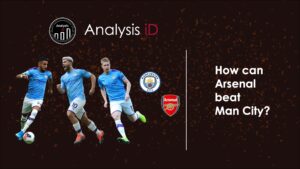Filling the gaps in data analysis with traditional/video scouting
INTRO
I wrote recently about the search for Arsenal’s next Centre Back using data (check it out here: Click Me). I will refer to that quite a lot in this piece, so probably worth a read in advance.
Naturally part 2 of this process, and what should always be a “part 2” of any recruitment analysis, is traditional scouting/video analysis. In my view, data can narrow the fishing net and help reduce risk but is a compliment to, not a replacement for, watching players. As much as data has advanced in the last 20 years, there are still aspects of performance that are picked up with the eye better than they are by the spreadsheet.
A huge caveat at this point: for the sake of this blog, I am going to do a video analysis based on one 90 minutes from the chosen players. If you were doing this for a club, of course you would watch multiple games of each player.
On we go…
Our initial data analysis gave us the following shortlist of interesting options who the model believed gave use the right blend of physicality, defensive ability and quality in possession:
– Felix Uduokhai – 22-year-old, Former German U21, currently playing for Augsburg on loan from Wolfsburg (admittedly less impressive in-possession but profiled so well otherwise that I thought he was worth inclusion here)
– Pau Torres – 23-year-old Spaniard, playing for Villareal
– Mohammed Salisu – 20-year-old 6”3 Ghanian playing for Valladolid
– Gabriel Magalhaes, 22-year-old Brazillian, currently at Lille
– Nico Elvedi – 23-year-old Swiss international, playing for Gladbach
– Sven Botman – 20-year-old Dutchman, playing for Heerenveen, on loan from Ajax
As well as Merih Demiral and Ibrahima Konate, who the model loved, though it was noted that Arsenal may well be priced out of moves for.
Centre Backs are all about partnerships and this is something we were unable to get to purely on the data. Hopefully some video analysis will shed some light on the playing styles of these players and how they might fit together at the heart of Arsenal’s defence.
STARTING WITH SALIBA
The natural place to start however seems to be with William Saliba. I framed part one with finding the long-term partner for the teenager who will be with Arsenal for the start of the next Premier League season.
I chose a recent game against Bordeaux to analyse and my thoughts are below.
It’s good news for Arsenal. He looked good in the model, and he looks superb on the grass. It’s not difficult to see what convinced Arsenal to pay a reported £27m for the then 18-year-old.
What strikes you initially, beyond his physical stature, is his composure. I wrote in part 1 about how Arsenal have had a real penchant recently for a certain type of defender – one who plays on the front foot, squeezes the pitch and wants to nip in front of attackers and win the ball high up the pitch. Saliba breaks that mold. Happy to play more on the back foot, the Frenchman is patient with his tackling and urge to intercept. There’s not a single slide tackle in 96 minutes, which comes as quite a shock after 3 ½ years of watching Mustafi in red and white. That composure continues into his in-possession work. While at times I did want him to punch his passes in with a bit more zip, he used the ball extremely well and demonstrated the ability to make what Wyscout would define as “Smart passes” (progressive, forward, line breaking).
I could write a whole blog in itself on what Saliba can bring to Arsenal, and in fact I may do, so I will leave the analysis on the teenager there for now and conclude with the following summary:
Saliba is good. And has a more composed style, which means I think he could fit with a front-foot defender (like a David Luiz) or another big, athletic, new addition.
So, what of the outlined options? One player who profiled well in the data analysis, was Nico Elvedi.
I picked a game against Wolfsburg, from December 2019, to watch for a couple of reasons.
1) I wanted him to be tested – The game was away from home and Wolfsburg are a decent team, who were having a good season.
2) I wanted to see him in a back four – Recently, Marco Rose’s side have alternated between playing 3 or 4 at the back. If he’s to move to Arsenal under Arteta, it would more than likely be in a back 4, in the long term.
STRENGTHS
Physical Tools
He’s a very good athlete. 6”2, lean and quick. He defended balls into the channels well, with decent starting positions and showed very good pace to get the better of Wolfsburg’s forwards, as demonstrated in the below clips.
Defensive IQ
I was also impressed by the Swiss defender’s decision making in defensive situations. Gladbach were occasionally exposed in transition with Elvedi left 1v1 or 1v2 at times. In these situations, he defended well and showed good defensive intelligence. Staying on his feet, not over committing, and forcing the attackers away from goal. Particularly in the 3rd clip below, I think he defends superbly, taking up a great position to defend the 1v2, forcing the play wide and then showing excellent recovery pace to get a block on the cross.
In Possession
In possession, Elvedi is solid. Technically he looks quite accomplished but plays within himself, at least in this game. His use of the ball is steady, if fairly conservative. His 92% pass completion rate was higher than anyone else on the pitch, though for context involved a lot of simple sideways passes. Two of his rare forward passes in this game are demonstrated below.
He takes few risks in possession, which is no bad thing. He looked like he might get himself into trouble on one occasion but showed decent feet to evade pressure and find his pass. Nothing spectacular, but demonstrated a level of competency with the ball at his feet.
As a left footer, he offers different passing angles in the buildup – something I think Arteta would like, as evidenced by his use of Xhaka in very deep positions in the first phase of possession. He’s comfortable with both feet however and displays probably a 60/40 split in terms of passes made with his left and right foot. He is used to playing in a team that plays out from the back (which would help his transition to Arsenal) – with Gladbach always looking to play out short in a familiar fashion… split centre backs with one or more deep midfielders dropping in to receive the ball.

WEAKNESSES
Positioning
I spoke about his good defensive IQ earlier, though this is not fully polished – and you would hope the key word to finish that sentence is “yet”. He’s an experienced player… for a 23-year-old. Naturally he still has some learning to do. I think he takes up quite a bad position in the below, you can see he is worried about the cutback, but fundamentally as a defender you must protect your goal. I’d like to see him a couple of yards deeper which would allow him to have a better, more open, body position.
On one occasion, he momentarily switches off at a set piece, allowing his man, John Brooks, to get a run on him. Although Brooks doesn’t get to the ball, Elvedi is well out of position and it’s a fortunate escape for Gladbach.
Interestingly, and on a completely coincidental side note, John Brooks also profiled well in the data, particularly when it came to aerial duels. The 6”4 American is another left-footed Centre Back and has a good game here, showing off his impressive physical tools.
These are very much isolated incidents with Elvedi, who in truth, is rarely in trouble in the game. Physically, he could perhaps do with developing a bit more power – even if it came through gym-work and at the sacrifice of a little bit of his impressive pace. Despite being a good athlete and a good size, he is not the stereotypical “commanding Centre Back”. Though perhaps he doesn’t have to be if he is to be paired with 6”4 William Saliba. He doesn’t win every header or 50/50 in this game. However, the context is important. He has a tough battle against 6”6 Dutch international Wout Werghorst. Far from being a criticism, I think this a positive. Overall, he does well in this battle, and you certainly wouldn’t claim Werghorst gets the better of him in the game. This ability, and willingness, to compete with physical Centre Forwards, bodes well for what he might potentially face in the Premier League, against Burnley’s Chris Wood and Ashley Barnes for example.
Some clips of his duels with Werghorst are below.
SUMMARY
Overall, there’s enough here to be positive about the Swiss international’s game. He’s very quick and athletic, technically sound and generally displays good defensive awareness and decision making. He could do nothing about either of the two goals his team conceded (they lost the game 2-1). Elvedi employs a more, composed, backfoot style of defending which would be a good contrast to the Arsenal’s current collection of defenders (beyond Saliba).
Certainly worth another watch.
Sven Botman
If Arsenal wanted to go down the route of another prospect, rather than someone potentially more ready to start straight away, Sven Botman was the standout player from Europe’s less coveted leagues – profiling extremely well for both aerial and ground duel success rates.
To assess the 20-year old Heerenveen player (on loan from Ajax), I analysed a one of their games from the end of February – a 3-2 win away at Twente.
STRENGTHS
Physicality
The young Dutchman looks a top athlete. He’s not as quick as Elvedi but is an inch taller and physically more imposing – yet still moves well and covers ground quickly with his large strides.
The two clips below show good recovery pace to make important challenges. The 2nd clip is particularly revealing. An impressive sprint that demonstrates his mobility and also evidence of good fitness levels, occurring in the 90th minute of the game.
He really is fantastic in the air, no surprise to see him profile so well in aerial duels in the data. You get some defenders who seem to enjoy being on the ball more than they like defending. Botman seem to one of those who seems to relish the physical battle with an opposition number 9. A selection of his headers won are below.
In Possession
Arsenal like defenders who are good with the ball at their feet, and this description certainly applies to Botman. Another left footer, the Dutchman passes crisply and is able to pass forward and find teammates between the lines. His Ajax education is apparent also in the way he moves to receive the ball. He shows a good awareness of passing angles and, often, doesn’t just play a pass and then jog back into his defensive position, but is clearly thinking about his next move to create a new passing lane.
Some clips of Botman in possession are presented below.
There’s an intensity to Botman’s defending. That is perhaps slightly lacking in Elvedi’s game. Difficult or describe or evidence, but there seems to be a good level of tenacity there.
WEAKNESSES
Defensive Positioning
In terms of the goals Heerenveen conceded on the day, Botman actually conceded a penalty for the first – I’m going to let you make your own minds up on this one… VAR had a good look at this one too…
For the second goal, Botman is bypassed too easily. To be fair he’s in a difficult position, having to mark two players. The mistake he makes is being too flatfooted and planted on his heels. It means in one quick move; the forward can bypass him and he’s unable to recover. He also maybe needed to give up defending the potential pass and concentrate only on engaging the ball carrier. It’s small margins, and everything happens vert quickly, but such is the nature of top level football.
It’s an interesting point on context. He’s conceded a penalty here and is bypassed easily for the second goal, yet I think he’s actually had a pretty good game overall.
One of the issues Botman did have in the game is the occasional tendency to get dragged towards the ball. This is a familiar issue for Arsenal fans, with overly zealous Centre Backs wanting to win the ball up the pitch, when maybe it’s not quite there to be won. There are a couple of occasions demonstrated below where a Twente player is free to receive between the lines and Botman tries to step up and apply pressure, leaving gaps in behind that Heerenveen were perhaps fortunate not to be punished for.
In the right set up, with a balanced defensive unit, this aggressive front-foot defending can be effective but relies on individuals picking their moments carefully as it can be high-risk high-reward. It looks naïve in the clips but context is important again here, it may be a coaching instruction he is following. Regardless, it’s not executed particularly well.
So, the part earlier, where I said I would only be watching 1 game for each player… I kind of lied. I thought Botman was such an interesting player, and someone I was not familiar with previously that I watched another of his games. In a weird quirk of Dutch football, he was able to play a league match against his parent club, Ajax.
Hereenveen lost the game the 3-1 and in truth, it was a very different game to the Twente one. Ajax were extremely dominant for 70 minutes with Hereenveen in a real deep block defensively, the kind most Arsenal will hope they will rarely see their side adopt, I imagine.
He’s still great in the air though.
I think the following clip encapsulates a few of the good parts of his games also. Good recovery and challenge, uses the ball well, and then directs his teammates to play a smart pass that can progress the ball up the pitch.
I’m reticent to uses pointing and gesturing as evidence that Botman is somehow going to be the next Tony Adams. I’ve seen some bad defenders do a lot of pointing and shouting on the pitch, often as a means of deflecting blame away from themselves. But this directing of teammates did seem to be a theme with the Dutchman. And may indicate some potential leadership qualities, or at least a decent understanding of the game.
One thing we haven’t talked about yet is league strength. It is certainly an important variable. How well Botman’s performances would translate to a tougher league is an important consideration. For me, there’s enough there. He could play at a higher level than he is currently.
I’m conscious of making this blog stupidly long so I will resist the urge to do video analysis on the other shortlisted defenders for now. I will watch the tapes and if there is anything interesting to report I may pick up the virtual pen again.
SUMMARY
So, what have we learned?
Can you use data to find centre backs? Possibly. It’s not easy but looks like we may have identified some interesting players here. I’m fairly happy that Aerial and Ground duel win% are reasonable KPIs (Key Performance Indicators) for Centre Backs, but we need to find more than 2. The question of how we quantify how often defenders are in the right position at the right time is a hugely valuable one. And one I will continue to develop my ideas around. We have to be more creative with the metrics looked at. If we can’t find useful metrics for defending from the usual sources, perhaps the answer is in creating our own and collecting our own data – something I know happens at football clubs already, though there is scope for something more innovative.
I have to be honest, if I was to compare the players studied here… I really like Botman. Not to say he is a better player than Elvedi currently – the Swiss player has far more pedigree and is far more proven – but there is something intriguing about Botman’s combination of physical and technical tools. Perhaps my inner Football Manager player has taken over. That urge to be a little bit hipster. To find the next rough diamond. I like the potential price, I like the upside. And I like what I see on the pitch. One to keep a close eye on for sure.
Back to the tapes…
Sancho Quinn, 20/04/20












